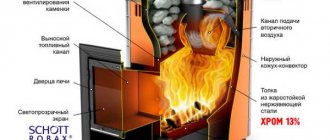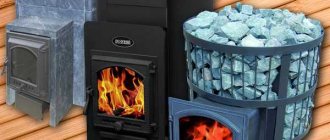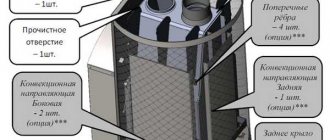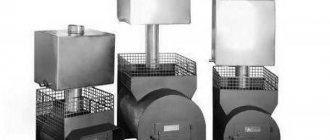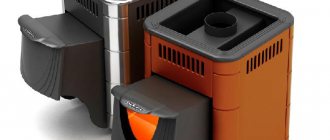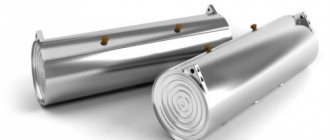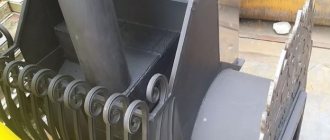On the Russian market of sauna stoves, Vulcan stoves have a good reputation. They are produced in Odintsovo at the Vulkankomplekt enterprise. There are 7 types of stoves today, plus they are produced in 10 modifications. There are models with an open or closed heater, some with a remote or built-in tank for heating water, and some without it at all. “Vulcan” sauna stoves are produced with different volumes of steam rooms: from 6-8m3 to 20m3. Plus, there are two combustion options: fuel is added in the same room or in an adjacent one, through the wall. Moreover, the remote firebox is protected by an arch. This makes installation easier: the arch does not heat up to critical temperatures, and there is no need to make part of the wall from heat-resistant bricks.
Time-tested sauna stoves Vulcan VU-05 and VU-09
New stoves for the Vulcan bathhouse
Since the second half of 2013, new modifications of the popular and proven models Vulcan VU-05 and VU-09 have appeared - Vector VU-05 and Vector VU-09. Their feature is a special convection kit and a mesh on the pipe for stones. For those who prefer dry steam, this is an ideal option.
Since the beginning of 2014, Vulcans have appeared in the premium class. These are the new Etna Premium sauna stoves, which are distinguished by a more sophisticated design. Moreover, the designers worked not only on the body itself, but also on the accessories for the pipe; they also developed a special cast-iron grate and four door options instead of the usual two.
New developments by Vulcan specialists. Etna Premium is distinguished by its non-standard, sophisticated design.
The old models Vulcan VU 02, 05, 07 have been replaced by new modified bathhouse stoves Elbrus 16, 20, 26, which have several modifications and configurations. There is also Elbrus 40, but it is classified as a sauna stove for commercial use - such a stove can heat a room from 25 to 40 m3. The category of “commercial” furnaces is not limited to Elbrus 40.
The main technical characteristics are summarized in a table. This will make it easier for you to navigate. Any of these models can be equipped with either a solid cast-iron door or a door with glass.
Main parameters of Vulcan sauna stoves
Prometheus 18 (Panorama modification)
Prometheus has a unique design due to its aesthetic mesh casing (see photo), thanks to which you can lay more stone for the stove.
And this, in turn, allows you to increase heat transfer and create a feeling of comfortable infrared radiation. This stove has design features similar to the Etna model, including a “ribbed” turbo firebox with increased thickness in some places and effective cast-iron grates that can “make” even damp wood burn. In addition, the manufacturer claims that the installed convection kit ensures faster heating of the stone.
- Steam room volume: from 8 to 18 m3
- Depth: 555 mm
- Width: 525 mm
- Height: 810 mm
- Weight of the oven itself: 85 kg
- Weight of stones: up to 200 kg (!)
In addition to the “18”, a more powerful model, the “24”, is produced. Each Prometheus has three modifications, with a cast iron or steel door, as well as with a small flat or large (see photo) panoramic thermoceramic glass.
Heating stoves
One of the lines of stoves for the Vesuvius - Elbrus bathhouse looks like this.
Vulcan also has heating stoves. This is the Alpina line, which quickly and effectively warms up the air in the room. Today there are three modifications in this category.
- “Mini” is the smallest, but it can heat rooms with a volume of 50 cubic meters, and it costs very little. Not the most sophisticated design, but if you need an inexpensive stove to heat a garage, greenhouse or any other similar space, then what can be done to suit the appearance, and the efficiency of the stove is very high.
- Alpina 200 is already designed for 200 cubic meters.
- "Alpina 250" - heats 250 cubic meters.
Large Alpines have two doors for loading fuel: the fuel compartment is very large and loading it from one door is inconvenient. A full stash burns and smolders for up to 20-24 hours. Such long-term combustion is ensured by the presence of a gas afterburning chamber, which makes it possible to create a firewood smoldering mode in which complete combustion of the fuel occurs.
The body of heating stoves has a ribbed surface, which increases heat transfer through the walls. In general, the design is quite simple, but effective, but what is needed for heating? Reliability and quality, and no one has yet complained about the quality of Vulcan stoves. In any case, we did not find any negative reviews. And the fact that after an old stove burns out, people come to buy a new one from the same company speaks volumes.
Heating stove "Vulcan" "Alpina-mini" - the most budgetary, but no less reliable option
Etna 20 Premium
This stove is distinguished by its original aesthetic design, and in addition:
- Innovative turbo-firebox ensuring high-quality combustion and economical fuel consumption;
- the developed ribbed surface of the firebox increases the total “heat removal” area and increases the service life;
- three-layer casing, creates soft radiation and comfortable conditions of outgoing steam;
- durable thermal glass, measuring 410 x 290 mm, makes it possible to admire and control the combustion process.
- Steam room volume: up to 20 m3
- Depth: 765 mm
- Width: 820 mm
- Height: 810 mm
- Weight of the “heat generator”: 90 kg;
- Weight of stones: up to 95 kg
The Etna model has a modification “26” (up to 26 m³ of heating), it is slightly larger in size and allows you to invest up to 120 kg of stone.
Advantages of Vulcan sauna stoves
Probably the most important advantage of these stoves is their high reliability at a low price. The average service life is 10 years. But this figure has recently become even higher: since December 2013, “Vulcans” began to be produced with fireboxes in which the steel thickness in the most loaded places is 10 mm (previously it was 5 mm). This improvement was made after a promotion carried out by the company: when purchasing a new stove, a 30% discount was provided if you brought an old one with a decent service life. Having analyzed the weak points of their products, the company developed a new firebox design. Now the service life declared by the manufacturers is 20 years.
This is what the Vulcan stove looks like in cross-section
Vulcan has several more features. The first is a double casing that softens the harsh heat radiation emanating from all iron stoves. The protection is quite effective, but if you want to get a stove exclusively for a Russian bath, you still have to line it with bricks. But the positive thing is that it doesn’t have to be firebrick. The double shield absorbs a fair amount of the heat and there is no need for increased fire ratings.
The second feature is the presence of a damper, which, as manufacturers say, switches the stove from the “sauna” mode to the “bath” mode. This damper blocks or opens the flow of hot air from the firebox to the stones. It was not possible to find data on how effectively such a damper works, but the idea seems sound, although it is not clear how much it actually affects the temperature of the stones. Stones, by the way, are also located in “Volcanoes” in a special way - in narrow gutters. This creates inconvenience during laying, but improves their heating.
The peculiarity of the firebox of the Vulcan sauna stoves is not only that they are now thicker in some places, but also that metal ribs are welded on the outside. Thus, it is given greater rigidity (the walls do not “walk” when heated) and heat transfer increases due to an increase in the surface of the metal. It must be said that these warm up the steam room quickly and easily. They say that one stack of wood is enough to maintain the temperature in a steam room for 4 hours. This is even noted as a minus: it is difficult to maintain the temperature in the range required for Russian steam.
Design features and advantages of the Vulcan sauna stove (clickable)
The undoubted advantages include the fact that Vulcan stoves can be heated with any solid fuel. What you have, you put it in the firebox. So for “Vulcans” the definition of wood-burning stoves is not entirely correct: they are heated with any solid fuel. But for a bathhouse, naturally, firewood is preferable.
The design of these ovens is generally well thought out. In order to be able to clean the firebox without removing the casing or disassembling the chimney, there are special holes. A retractable ash tray is provided to collect ash. The intensity of combustion also depends on its position.
Model Taal 14
Compact dimensions allow Taal 14 to be used in small bathhouses. The price is also quite “compact”. The stove can be placed so that firewood can be supplied from the steam room or from an adjacent room. Here are the parameters of this model:
- Steam room volume from 8 to 14 m3
- Double casing around the firebox
- Depth: 360 mm
- Width: 410 mm
- Height: 710 mm
- Weight of the stove itself: 57 kg
- Weight of stones: up to 40 kg
Design features:
- Furnace wall thickness: 5 mm
- Chimney diameter: 110 and 115 mm
- Length of laid firewood: up to 300 mm.
Two numbers written after the name of some Vulcan models indicate the maximum heated volume of the steam room in cubic meters. For example, Taal 14 means that the steam room that this model can “serve” is up to 14 m³.
Disadvantages of Vulcan stoves
We didn't find any negative reviews at all. The general impression is that they are good, well-made metal stoves with all their pros and cons. The disadvantages include several design flaws, which, in principle, are not critical, but reduce the comfort of use.
- The water tank for Vulcan stoves has a small volume (20-40 liters). In addition to the need to drain/add water, there is another nuisance: in a small tank, the water boils before the steam room warms up. If we take models with a hinged tank, a different picture arises - the water takes too long to heat up, which is also not good. According to reviews, the best option is either to take models with remote tanks, or without them at all, and to heat the water, install a separate electric or wood-burning boiler (as conditions allow).
- There is one more inconvenience for models with a built-in tank - the tap for draining hot water is not located very well - if the stove is heated from an adjacent room, then the tap is located too close to the wall, which creates inconvenience.
- Models with remote heat exchangers have a lead diameter of ½ inch, although ¾ would be optimal, but this is already in the area of “process optimization”. The water flows well, but, as often happens, I would like it to be better.
- There is a purely theoretical drawback: the effectiveness of the damper, which switches modes from bath to sauna, is questionable. We did not find any reviews from owners of such “Vulcans” using the function. So how this option works is unknown.
These are all the shortcomings that we found while reading reviews from owners and experienced bathhouse attendants who analyzed the technical data of Vulcan bathhouse stoves (there are also heating stoves, but we didn’t look into them).
This is a photo of the weld around the smoke pipe (left click on it to enlarge)
Reviews
Now the reviews themselves. We present impressions from the operation of sauna stoves only, not heating ones.
“I had two Vulcans, both for a long time. Each one is more than 10 years old. Moreover, it is still a secret to me what kind of steel they use. Externally, they are ordinary black metal, but they do not burn through. The stove is good, but for a Russian bath you need “dancing with a tambourine” in full: a brick screen, a steam gun and a convector on a pipe.”
Alexander, Moscow
My Vulcan is already an old man. And I would be glad to exchange it for a new model (I like the Harmony), but it won’t burn out, it doesn’t seem like it’s even going to. And we only heat it with birch, and harshly: I love high temperatures.
This is a photo of the welded seam of the firebox (to enlarge the size, click on it with the left mouse button)
Fedor, Kaluga
My Vulcan is already three years old, U16 or 16U, I don’t even remember. My insulation is average. In an hour, the steam room in winter (14 cubic meters) heats up to 90°. I had friends who were extreme sports enthusiasts, and they reached 140°C with oak in 30-40 minutes. I'm happy with this stove, but I'll have to change the pipe to an insulated one, otherwise there's already one leaning against it.
Mikhail, Tver
I prefer the Russian steam room, which is not hot, but I decided to test how the damper on the Vulcan works. After steaming, I turned the handle. in a minute the temperature rose from 80 to 90. This despite the fact that the wood was no longer burning, probably due to the stones.
Alexey, Moscow
There is still an old Vulcan with a 30 liter tank. Everything is fine except this tank itself. Water boils very quickly and very early. Moreover, the tap is located so low that you need to draw water either by bending over or kneeling. Neither one nor the other makes me happy. And in general, I became convinced that the water tank in the steam room is pure evil. If it boils, it’s on guard, everything is steamed, and it’s kind of sticky. And if you don’t leave it empty, it will burn. I decided for myself: it’s better to install a separate water heater and not toil all the time.
Vladimir, Vologda
How to install
For safe operation, sauna stoves require a non-combustible base. Due to the fact that the weight of the stoves is small, a separate foundation for them is not necessary. If fire-resistant material is laid on wood, the thickness of the non-combustible base must be at least 7 cm. The foundation on which the stove is installed must be 7-10 cm larger than its dimensions in any direction. To protect from falling coals, it is advisable to protect the floor in front of the stove with either a metal sheet or ceramic tiles laid on a non-combustible base. The dimensions of this area are no less than 50*70cm.
It is important to correctly install a wood-burning sauna stove
There are two ways to place the stove in the bathhouse: so that it is heated from another room or placed entirely in the steam room. If the firebox is located in an adjacent room, the passage through the wall must be non-flammable (the part of the wall adjacent to the stove is made of brick, the distance between the stove and the brick is additionally filled with mineral wool). At the same time, the distance from the stove to the nearest combustible wall must be at least 50 cm; if the wall is protected by non-combustible material, the minimum distance is 36 cm. The wall opposite the door must be at a distance of at least 125cm.
For recommendations on chimney installation, see this video.
It is important to correctly route the chimney through the walls, ceilings and roof: the temperature of the pipe can sometimes be very high, so fire safety must be observed. For this purpose, special or homemade feedthrough units are used.
Installation of stoves for the Vulcan bathhouse
Approximate installation diagram for Vulcan sauna stoves.
Vulcan sauna stoves also have important advantages: compact size and low weight of 60-100 kilograms without stones. Two men can easily handle such a mass, which also reduces delivery costs. The small mass of the stove has another positive point: it is not necessary to make a foundation for the stove. It is enough to prepare a decent basis:
- Place a layer of brick at the location where the stove is installed. The dimensions of the brick base are at least 20-30 cm larger than the dimensions of the stove.
- Place a sheet of asbestos on top, and then a sheet of stainless steel.
- The entire structure is fastened with spacer bolts into the brick.
That's all, the base for the Vulcan sauna stove is ready. There is another option for preparing the foundation for the “Vulcan”: lay out the adjacent wall and floor with porcelain stoneware slabs (approximately 120 cm wide and 140 cm high).
We remind you that there are floor screens for metal stoves. Many screen models can withstand significant loads. Floor screens are described in the article How to choose a stove (boiler) screen for a bath
If the stove is made with the firebox moved to another room, the gap between the wall and the arch can be filled with insulation (it’s up to you to use basalt wool or another material). To ensure good draft in this case, the chimney pipe is brought out with a 90° elbow into the wall, and then with another 90° turn up.
Elbrus 16 (Panorama modification)
It has, as they say, increased comfort and durability. Which of course increases the price. In particular:
- Panoramic window made of heat-resistant ceramics (glazing area: 410 x 290 mm);
- enhanced protection against excessive thermal effects (double casing);
- special design of the cast iron grate for stable combustion, even of wet firewood;
- reinforced firebox (in areas of maximum heating, carbon steel thickness = 10 mm);
- convenient hole for cleaning the combustion chamber;
- The chimney pipe pipe is made of steel 8 mm thick, for diameters of 110 and 115 mm.
- Steam room volume, from 6 to 16 m3
- Depth: 535 mm
- Width: 410 mm
- Height: 810 mm
- Heating unit weight: 84 kg
- Weight of stones: up to 75 kg
In addition to the Elbrus 16 model, there are more powerful modifications (18, 20, 24 and 26). Elbrus is available in different versions: with cast iron or steel doors, with small windows made of tempered glass or large panoramic windows made of thermoceramics. It is possible to connect a hot water tank (from 31 to 45 l) or a heat exchanger, allowing the use of tanks with a capacity of 60, 80, 100 and 120 l.
